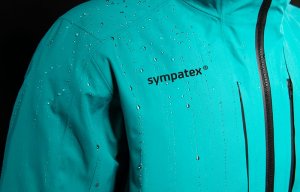
Sympatex a Best for the World B Corp
wear2wear is an innovative industrial partnership dedicated to high-quality, as well as sustainable clothing.

15th December 2017
Innovation in Textiles
|
Munich/Unterföhring
To close the resource cycle, these textiles can be completely recycled at the end of their life cycles, the company reports. Thus, waste is prevented, and new textiles are manufactured instead. Sympatex invites its customers as well as interested garment manufacturers and authorities to close the textile loop with the help of wear2wear. Individual solutions are jointly developed in the so-called Sympathy Lab.
wear2wear is an innovative industrial partnership dedicated to high-quality, as well as sustainable clothing, in which five European companies, representing each phase of the recycling process, have joined together to develop cutting-edge production systems that will turn textile fibres from used clothing into new functional fabrics. The company is a supplier of the 100% climate-neutral, recyclable, PTFE-free and PFC-free membrane within this association.
Sympatex fosters its agenda 2020 with wear2wear, which the Munich company announced at ISPO in February 2017. Part of this strategy is to offer completely pollution-free, recycled and again recyclable functional textiles by 2020.
“We have launched an open platform with our wear2wear cooperation which is able to completely close the polyester cycle for textiles – from the collection to the new textile,” explained Dr Rüdiger Fox, CEO of Sympatex Technologies. “It is available for all other partners who are committed to a closed materials cycle in the textile industry – and with each additional member, we are getting closer to soon realize a sustainable clothing industry.”
Another element of this sustainability strategy is to neutralise the overall ecological balance of the clothing cycle as far as possible. Sympatex offers a membrane, which is said to be manufactured in a completely climate-neutral way. The manufacture of a Sympatex copolymer already produces around 50 times less CO2 compared to a similar PTFE membrane, the company reports.
In order to eliminate any contribution to global warming, Sympatex has now also been compensating the remaining CO2 amount of its entire annual membrane production since this year by participating in certified international climate protection projects.
The functional specialist also supports its customers and market partners to completely shift to climate-neutral clothing: the CO2 emission of each individual running meter textile can be precisely identified as part of the ecological footprint by means of the Sympatex eco calculator. Sympatex customers can also compensate the inevitable CO2 emissions when taking part in climate protection projects.
Moisture-Tech by Sympatex gains ever more popularity. The highly functional shoe technology ensures an optimum micro climate and is in particular suitable for safety and fire boots. “Moisture is quickly wicked away from the foot and cannot re-enter the inner lining due to the outward suction effect by using the extremely absorbent material. The advantage: high wear comfort and dry feet for maximum performance in all weathers,” the company explains.
Thus, the high-performance lining technology is especially suitable for police, fire and custom staff. As of recently, the French police are using it in motor cycle boots from Paraboot. In the field of safety and fire boots, Honeywell, Baltes , Rock Fall , Maxguard and Völkl , amongst others, already use Moisture-Tech by Sympatex. And the Italian new customer Diadora now uses Moisture-Tech by Sympatex directly in the first common model series, which were presented at A+A for the first time.

Business intelligence for the fibre, textiles and apparel industries: technologies, innovations, markets, investments, trade policy, sourcing, strategy...
Find out more